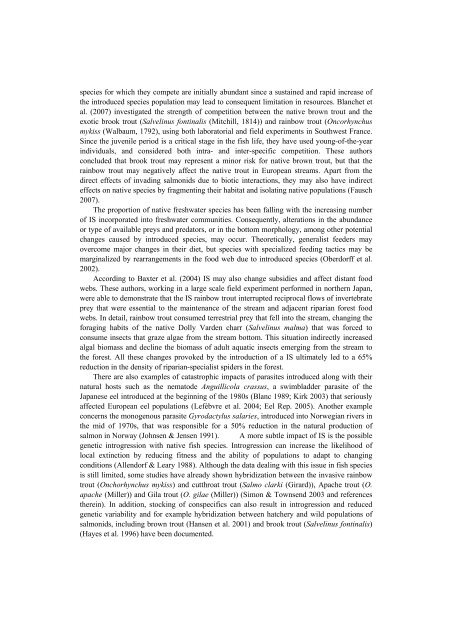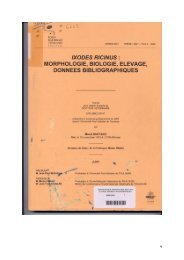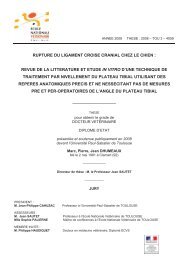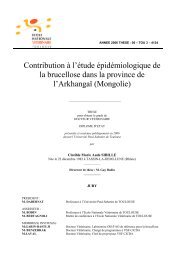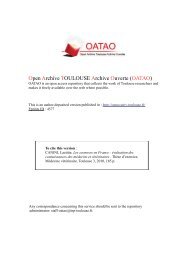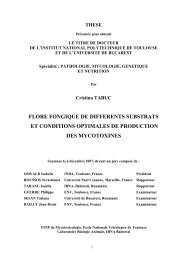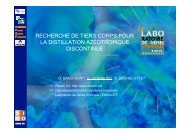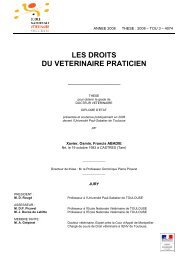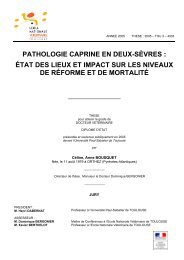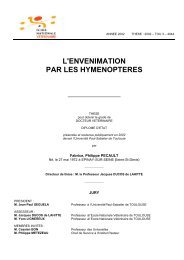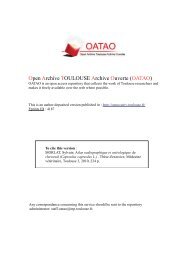PDF ( Author's version) - OATAO (Open Archive Toulouse Archive ...
PDF ( Author's version) - OATAO (Open Archive Toulouse Archive ...
PDF ( Author's version) - OATAO (Open Archive Toulouse Archive ...
You also want an ePaper? Increase the reach of your titles
YUMPU automatically turns print PDFs into web optimized ePapers that Google loves.
species for which they compete are initially abundant since a sustained and rapid increase of<br />
the introduced species population may lead to consequent limitation in resources. Blanchet et<br />
al. (2007) investigated the strength of competition between the native brown trout and the<br />
exotic brook trout (Salvelinus fontinalis (Mitchill, 1814)) and rainbow trout (Oncorhynchus<br />
mykiss (Walbaum, 1792), using both laboratorial and field experiments in Southwest France.<br />
Since the juvenile period is a critical stage in the fish life, they have used young-of-the-year<br />
individuals, and considered both intra- and inter-specific competition. These authors<br />
concluded that brook trout may represent a minor risk for native brown trout, but that the<br />
rainbow trout may negatively affect the native trout in European streams. Apart from the<br />
direct effects of invading salmonids due to biotic interactions, they may also have indirect<br />
effects on native species by fragmenting their habitat and isolating native populations (Fausch<br />
2007).<br />
The proportion of native freshwater species has been falling with the increasing number<br />
of IS incorporated into freshwater communities. Consequently, alterations in the abundance<br />
or type of available preys and predators, or in the bottom morphology, among other potential<br />
changes caused by introduced species, may occur. Theoretically, generalist feeders may<br />
overcome major changes in their diet, but species with specialized feeding tactics may be<br />
marginalized by rearrangements in the food web due to introduced species (Oberdorff et al.<br />
2002).<br />
According to Baxter et al. (2004) IS may also change subsidies and affect distant food<br />
webs. These authors, working in a large scale field experiment performed in northern Japan,<br />
were able to demonstrate that the IS rainbow trout interrupted reciprocal flows of invertebrate<br />
prey that were essential to the maintenance of the stream and adjacent riparian forest food<br />
webs. In detail, rainbow trout consumed terrestrial prey that fell into the stream, changing the<br />
foraging habits of the native Dolly Varden charr (Salvelinus malma) that was forced to<br />
consume insects that graze algae from the stream bottom. This situation indirectly increased<br />
algal biomass and decline the biomass of adult aquatic insects emerging from the stream to<br />
the forest. All these changes provoked by the introduction of a IS ultimately led to a 65%<br />
reduction in the density of riparian-specialist spiders in the forest.<br />
There are also examples of catastrophic impacts of parasites introduced along with their<br />
natural hosts such as the nematode Anguillicola crassus, a swimbladder parasite of the<br />
Japanese eel introduced at the beginning of the 1980s (Blanc 1989; Kirk 2003) that seriously<br />
affected European eel populations (Lefèbvre et al. 2004; Eel Rep. 2005). Another example<br />
concerns the monogenous parasite Gyrodactylus salaries, introduced into Norwegian rivers in<br />
the mid of 1970s, that was responsible for a 50% reduction in the natural production of<br />
salmon in Norway (Johnsen & Jensen 1991). A more subtle impact of IS is the possible<br />
genetic introgression with native fish species. Introgression can increase the likelihood of<br />
local extinction by reducing fitness and the ability of populations to adapt to changing<br />
conditions (Allendorf & Leary 1988). Although the data dealing with this issue in fish species<br />
is still limited, some studies have already shown hybridization between the invasive rainbow<br />
trout (Onchorhynchus mykiss) and cutthroat trout (Salmo clarki (Girard)), Apache trout (O.<br />
apache (Miller)) and Gila trout (O. gilae (Miller)) (Simon & Townsend 2003 and references<br />
therein). In addition, stocking of conspecifics can also result in introgression and reduced<br />
genetic variability and for example hybridization between hatchery and wild populations of<br />
salmonids, including brown trout (Hansen et al. 2001) and brook trout (Salvelinus fontinalis)<br />
(Hayes et al. 1996) have been documented.


